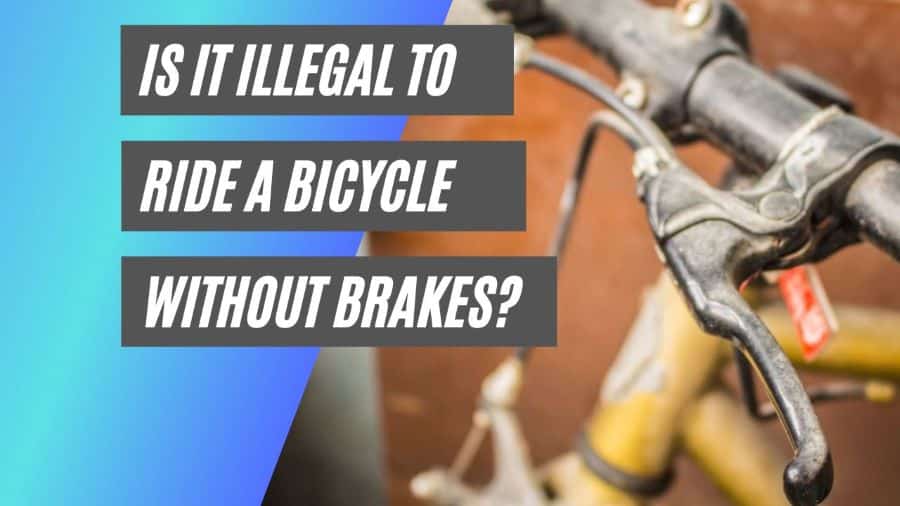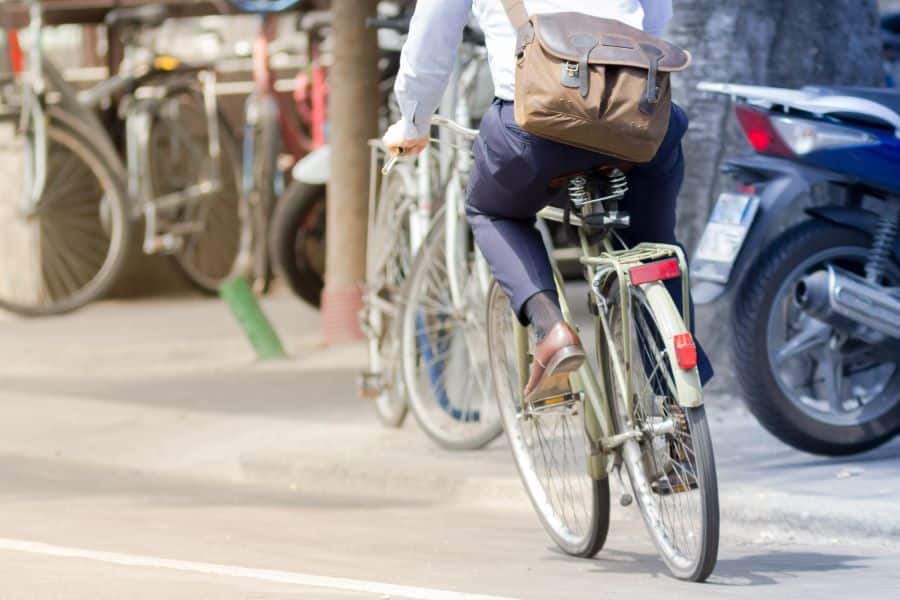This post may contain affiliate links. If you click an affiliate link and make a purchase, I may earn a commission. Also, as an Amazon Associate, I earn from qualifying purchases.--
If you’re considering riding your bike without brakes, you might be wondering whether it’s illegal or if it’s just generally unsafe. The answer to that question depends on where you live and what laws apply to you.
In the majority of states in the US, it is illegal to ride a bicycle without brakes. This includes many of the more populous areas, including California, Florida, and Texas. It is also illegal in many other countries around the world.
Read on to learn more about the legality of riding bikes without brakes and what factors should be considered while deciding whether or not it’s okay to ride without brakes in your city, state, or country of residence!

Can you Ride a Bike With no Brakes?
It is illegal to ride a bicycle without brakes in the majority of States in the US. This includes all of the following:
- Texas
- Florida
- California
- New York State
- Delaware
- Tennessee
- Oregon
- Ohio
- Utah
- Arizona
There are very few states (if any) where it is actually legal to ride without brakes.
What The Law Includes In Populous States
Here are some examples of what the individual laws state in some States. I have particularly selected the most populous three States in the US:
California – ‘Bicycles must be equipped with a brake that allows you to make a one braked wheel skid on dry, level, clean pavement‘ (Source)
Texas – ‘Every bike must be equipped with a brake capable of making a braked wheel skid on dry, level, clean pavement.’ (Source)
Florida – ‘Every bicycle must have brakes which enable the bicyclist to stop within 25 feet from a speed of 10 miles per hour on dry, level, clean pavement.‘ (Source)
Other Countries Where It Is Illegal To Ride Without Brakes
Most Western countries have laws that ban cyclists from riding without brakes.
Here are some countries where this is definitely the case:
- Spain
- France
- United Kingdom
- Germany
- Japan
- Australia
Most of these countries actually specify that you need two working brakes – one for the front wheel and one for the back. This does not apply to all countries though (such as Japan that currently only needs one brake).
Note – Consult a lawyer or your local cycling group if you are unsure whether or not it is allowed to ride a bike without brakes in your state.
Why are Front Brakes Important for Bikes?
A road bike’s front brake is its primary stopping mechanism. It’s the better of the two brakes available. When the front brakes are applied, the vehicle’s center of mass moves to the front, where it can benefit from the increased traction and avoid a skid.
Braking techniques will improve with experience, especially for fast bikers.
When it comes to stopping power, the front brake is unrivaled, while the rear brake is best used for maintaining control over velocity in challenging environments with poor grip.
A front brake uses the wheel’s contact with the road to generate stopping force. Because this location is in front of your bike’s center of gravity, when you apply the brakes, your body weight acts like a lever, pressing the tire down into the pavement and creating friction.
If you apply too much brake pressure, you could cause the tire to lock up, which could lead to a flip.
However, once you apply the additional downward force, the friction between the tire and the ground effectively helps the bike to stop quickly.

Why are Rear Brakes not as Helpful?
When you use your rear brake, the only thing stopping your vehicle is the friction between the wheel and the pavement.
When you’re riding with rear brakes only, your body weight is the only force acting downward on the rubber, driving it into the pavement.
But this downward force is not as effective in stopping the bike because the weight gets divided to the front brake.
Anyone who has ridden a bike as a youngster with a coaster brake knows how easy it is to lock up the wheel and slide the tire.
With rear brakes, it takes more time to stop since you have less friction and are therefore less in control.
What Bike does not have Brakes?
Fixie bikes, also known as fixed gear bikes, are a form of single-speed bicycle that lack a freewheel. With fixie bikes, as long as the wheel is turning, you must keep your foot on the pedal at all times.
A fixie bike is more efficient, pleasant to ride, and low-maintenance than conventional bicycles. As a result, you can travel faster for the same amount of work.
Many subcultures have adopted it, including bike messengers, hipsters, and the contemporary city cyclist. They’ve all kind of merged into one another, creating a brand-new scene for fixed-gear cyclists.
As a result of its proven capacity to improve the effectiveness of cycling exercises, it has gained widespread popularity among current fitness enthusiasts.
However, the real use of fixie bikes comes through in velodrome competitions. On a velodrome track, braking and slowing down the bike is not required or recommended because each cyclist is riding at a similarly fast pace that is much higher than bikers on roads.
Fixie bikes were specifically designed while keeping these races in mind where braking or slowing down can put other riders at risk of collision because they are riding closer together. (Source)
Why are Fixed Gear Bikes not recommended for going Uphill?
Hill climbing is not a good idea on a fixed-gear bike. The more effort you put into pedaling, the higher you’ll go. Going downhill isn’t any easier, but at least you’ll pick up speed thanks to gravity.
It’s possible to lose all rear tire grip and skid downhill if you rely solely on your legs as brakes. Going downhill is risky because you have so little control.
However, some climbers like to use fixed-gear bikes because they feel it improves their strength and stamina.
How to Control the Brakes on the Bike?
Bicycles typically have a lever on the left handlebar for the front brake and a lever on the right handlebar for the rear brake. When stopping, the rear brake should be used first, especially if you are a beginner rider.
Similarly, upon stopping, remove the front brake first, then the back.
You can reduce the risk of losing control of the bike and going over the handlebars by activating the front brake while keeping the rear brake engaged.
Keep your weight back when braking, apply equal force to both brakes and release the front first, followed by the rear. This requires incredible mental focus so make sure you keep on practicing to make your shifting effortless!
How to Ride a Bike without Brakes?
Are you in a country where it is legal to ride a bike without brakes? And, if so, do you need to ride a bike without brakes?
Well, this is not an easy task. Some people might think that it is impossible to ride a bike without brakes but that’s not true at all. There are many ways for you to train yourself for riding a bike without brakes.
Don’t make the rookie move of honing your skills on a full track or a busy metropolitan street if your bike doesn’t have brakes.
Learn the ropes in safety by practicing on an empty track or street.
You’ll be able to steer the bike like you normally would, but pedaling and stopping will feel a little different than on a standard freewheel bike. Let’s find out more about how you can acquire this incredible skill!
Adjust the Seat & Pedals
Make sure that when you sit in the saddle, at least one of your feet is touching the ground.
You can always adjust the height of your seat at a later time, but right now you need to be able to reach the floor. In the case of clip-in or caged pedals, you should use the non-clip side of the pedal when riding.
When you’re first getting started, you don’t want to risk getting your feet jammed in the pedals.
To adjust the pedals to the correct position, stand next to the bike, pull up slightly on the frame to lift the back wheel off the ground, and then press the nearest pedal forward with your inner foot.
Practice Skipping
Skipping is an effective stopping technique that requires you to lift your body off the saddle while simultaneously shifting your weight to the outside pedal.
When the pedals are at level, a “kick” is executed by pulling up on the forward pedal and pressing down on the front pedal. This causes the back wheel to cease turning.
If you want to skip twice in a row, after the first time, let the pedals return to the horizontal position by moving them forward.
You may need to repeat this several times before you can stop, depending on how fast you are traveling. The wheels of a fixed-gear bike will turn in reverse if you put the chain in a forward motion; this is because the chain must always be in motion.
Final thoughts
While riding a bike without brakes is illegal in most areas, if you are unsure then it makes sense to check with your local laws and community before you hit the roads to avoid any legal complications.
